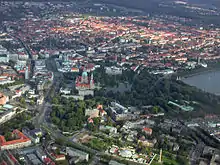List of cities in the European Union by population within city limits
This is a list of the largest cities in the European Union according to the population within their city boundary. The cities listed all have populations over 300,000. The list deals exclusively with the areas within city administrative boundaries as opposed to urban areas or larger urban zones (metropolitan areas), which are generally larger in terms of population than the main city.
As some cities have a very narrow boundary and others a very wide, the list may not give an accurate view of the comparative magnitude of entire urban areas, and thus the figures in the list should be treated with caution. For example Paris is the most populous urban area in the European Union, however the city proper of the French capital has a lower population than top ranked Berlin and a couple of other cities, as shown in the table. Likewise the City of Brussels is only one of a total of 19 municipalities making up the greater Brussels Capital Region, and by itself does not reach the population threshold to be listed here.
Cities by population within the city boundary
Cities in bold are capital cities of their respective countries.
| Rank | City | Member state |
Official population |
Date | Reference | Photography |
|---|---|---|---|---|---|---|
| 1 | Berlin | 3,755,251 | 31 December 2022 | [1] |  | |
| 2 | Madrid | 3,280,782 | 1 January 2022 | [2] | %252C_vistas_19.jpg.webp) | |
| 3 | Rome | 2,748,109 | 1 January 2023 | [3] |  | |
| 4 | Bucharest | 2,162,281 | 1 July 2022 | [4] |  | |
| 5 | Paris | 2,102,650 | 1 January 2023 | [5] |  | |
| 6 | Vienna | 1,982,442 | 1 January 2023 | [6] | -Stephansdom_Vienna_July_2008_(31).jpg.webp) | |
| 7 | Hamburg | 1,892,122 | 31 December 2022 | [1] |  | |
| 8 | Warsaw | 1,861,644 | 30 June 2023 | [7] |  | |
| 9 | Budapest | 1,671,004 | 1 January 2023 | [8] |  | |
| 10 | Barcelona | 1,636,193 | 1 January 2022 | [2] | _(cropped).JPG.webp) | |
| 11 | Munich | 1,512,491 | 31 December 2022 | [1] |  | |
| 12 | Prague | 1,357,326 | 1 January 2023 | [9] |  | |
| 13 | Milan | 1,354,196 | 1 January 2023 | [3] |  | |
| 14 | Sofia | 1,280,334 | 31 December 2022 | [10] | .jpg.webp) | |
| 15 | Cologne | 1,084,831 | 31 December 2022 | [1] |  | |
| 16 | Stockholm | 984,748 | 31 December 2022 | [11] |  | |
| 17 | Amsterdam | 921,402 | 31 December 2022 | [12] | .jpg.webp) | |
| 18 | Naples | 913,462 | 1 January 2023 | [3] |  | |
| 19 | Marseille | 870,321 | 1 January 2020 | [13] |  | |
| 20 | Turin | 841,600 | 1 January 2023 | [3] |  | |
| 21 | Kraków | 804,237 | 30 June 2023 | [7] |  | |
| 22 | Valencia | 792,492 | 1 January 2022 | [2] |  | |
| 23 | Frankfurt am Main | 773,068 | 31 December 2022 | [1] |  | |
| 24 | Zagreb | 767,445 | 30 June 2022 | [14] | .jpg.webp) | |
| 25 | Seville | 681,998 | 1 January 2022 | [2] |  | |
| 26 | Wrocław | 674,132 | 30 June 2023 | [7] |  | |
| 27 | Zaragoza | 673,010 | 1 January 2022 | [2] | .jpg.webp) | |
| 28 | Helsinki | 665,558 | 1 February 2023 | [15] |  | |
| 29 | Rotterdam | 663,945 | 31 December 2022 | [12] |  | |
| 30 | Łódź | 655,279 | 30 June 2023 | [7] |  | |
| 31 | Copenhagen | 653,664 | 1 January 2023 | [16] |  | |
| 32 | Athens | 637,798 | 23 October 2021 | [17] |  | |
| 33 | Stuttgart | 632,865 | 31 December 2022 | [1] | .jpg.webp) | |
| 34 | Palermo | 630,167 | 1 January 2023 | [3] |  | |
| 35 | Düsseldorf | 629,047 | 31 December 2022 | [1] |  | |
| 36 | Leipzig | 616,093 | 31 December 2022 | [1] |  | |
| 37 | Riga | 614,987 | 1 January 2023 | [18] |  | |
| 38 | Gothenburg | 596,841 | 31 December 2022 | [11] |  | |
| 39 | Dortmund | 593,317 | 31 December 2022 | [1] |  | |
| 40 | Dublin | 588,233 | 3 April 2022 | [19] | -135491_(39626174772).jpg.webp) | |
| 41 | Essen | 584,580 | 31 December 2022 | [1] |  | |
| 42 | Vilnius | 583,098 | 1 July 2023 | [20] |  | |
| 43 | Málaga | 579,076 | 1 January 2022 | [2] |  | |
| 44 | Bremen | 569,396 | 31 December 2022 | [1] |  | |
| 45 | Dresden | 563,311 | 31 December 2022 | [1] | .jpg.webp) | |
| 46 | The Hague | 562,501 | 31 December 2022 | [12] | .jpg.webp) | |
| 47 | Genoa | 558,745 | 1 January 2023 | [3] |  | |
| 48 | Lisbon | 548,703 | 1 January 2022 | [21] | .jpg.webp) | |
| 49 | Hanover | 545,045 | 31 December 2022 | [1] |  | |
| 50 | Poznań | 540,146 | 30 June 2023 | [7] |  | |
| 51 | Antwerp | 536,079 | 1 January 2023 | [22] |  | |
| 52 | Nuremberg | 523,026 | 31 December 2022 | [1] |  | |
| 53 | Lyon | 522,228 | 1 January 2020 | [13] |  | |
| 54 | Duisburg | 502,211 | 31 December 2022 | [1] |  | |
| 55 | Toulouse | 498,003 | 1 January 2020 | [13] |  | |
| 56 | Gdańsk | 486,492 | 30 June 2023 | [7] |  | |
| 57 | Bratislava | 476,677 | 1 March 2023 | [23] |  | |
| 58 | Murcia | 462,979 | 1 January 2022 | [2] | _Vista_del_Este_de_Murcia_desde_la_Camapana_de_San_Jos%C3%A9_de_la_Catedral_de_Murcia_(1)_(5373232199)_(cropped).jpg.webp) | |
| 59 | Tallinn | 453,864 | 1 January 2023 | [24] |  | |
| 60 | Palma de Mallorca | 415,940 | 1 January 2022 | [2] |  | |
| 61 | Brno | 396,101 | 1 January 2023 | [9] |  | |
| 62 | Iași | 393,574 | 1 July 2022 | [4] |  | |
| 63 | Szczecin | 390,278 | 30 June 2023 | [7] |  | |
| 64 | Sintra | 388,767 | 1 January 2022 | [21] | .jpg.webp) | |
| 65 | Bologna | 387,971 | 1 January 2023 | [3] | .jpg.webp) | |
| 66 | Las Palmas | 378,797 | 1 January 2022 | [2] |  | |
| 67 | Utrecht | 367,781 | 31 December 2022 | [12] | ||
| 68 | Bochum | 365,742 | 31 December 2022 | [1] |  | |
| 69 | Aarhus | 361,544 | 1 January 2023 | [16] |  | |
| 70 | Florence | 360,930 | 1 January 2023 | [3] |  | |
| 71 | Wuppertal | 358,876 | 31 December 2022 | [1] |  | |
| 72 | Malmö | 357,377 | 31 December 2022 | [11] | .jpg.webp) | |
| 73 | Bilbao | 344,127 | 1 January 2022 | [2] |  | |
| 74 | Nice | 343,477 | 1 January 2020 | [13] |  | |
| 75 | Alicante | 338,577 | 1 January 2022 | [2] |  | |
| 76 | Bielefeld | 338,332 | 31 December 2022 | [1] | ||
| 77 | Bonn | 336,465 | 31 December 2022 | [1] |  | |
| 78 | Lublin | 330,447 | 30 June 2023 | [7] | ||
| 79 | Cluj-Napoca | 328,418 | 1 July 2022 | [4] | .jpg.webp) | |
| 80 | Bydgoszcz | 328,370 | 30 June 2023 | [7] |  | |
| 81 | Plovdiv | 321,824 | 31 December 2022 | [10] |  | |
| 82 | Münster | 320,946 | 31 December 2022 | [1] | _(3).jpg.webp) | |
| 83 | Nantes | 320,732 | 1 January 2020 | [13] |  | |
| 84 | Varna | 319,900 | 31 December 2022 | [10] |  | |
| 85 | Córdoba | 319,515 | 1 January 2022 | [2] |  | |
| 86 | Thessaloniki | 317,778 | 23 October 2021 | [17] |  | |
| 87 | Bari | 316,015 | 1 January 2023 | [3] | ||
| 88 | Mannheim | 315,554 | 31 December 2022 | [1] |  | |
| 89 | Timișoara | 311,651 | 1 July 2022 | [4] |  | |
| 90 | Karlsruhe | 308,707 | 31 December 2022 | [1] |  | |
| 91 | Vila Nova de Gaia | 307,563 | 1 January 2022 | [21] | _(cropped).jpg.webp) | |
| 92 | Espoo | 306,792 | 1 February 2023 | [15] |  | |
| 93 | Galați | 304,692 | 1 July 2022 | [4] |  | |
| 94 | Kaunas | 304,459 | 1 July 2023 | [20] |  | |
| 95 | Constanța | 302,976 | 1 July 2022 | [4] | .jpg.webp) | |
| 96 | Augsburg | 301,033 | 31 December 2022 | [1] |  |
See also
References
- "Städte (Alle Gemeinden mit Stadtrecht) nach Fläche, Bevölkerung und Bevölkerungsdichte am 31.12.2022" (in German). Federal Statistical Office of Germany. 21 September 2023. Retrieved 24 October 2023.
- "Municipal breakdown". Instituto Nacional de Estadística. Retrieved 21 April 2023.
- "Resident population on 1st January". Italian National Institute of Statistics. Retrieved 6 July 2023.
- "Legally resident population of counties, municipalities and towns, on July 1, 2022" (PDF). Romanian Statistical Yearbook 2022. National Institute of Statistics of Romania. 10 April 2023. pp. 61–64. Retrieved 21 April 2023.
- "Estimation de la population au 1er janvier 2023" (in French). Institut national de la statistique et des études économiques. 24 January 2023. Retrieved 11 April 2023.
- "Population at beginning of year/quarter". Statistics Austria. Retrieved 14 February 2023.
- "Population. Size and structure and vital statistics in Poland by territorial division in 2022. As of 30 June (Table III)". Statistics Poland. 16 October 2023. Retrieved 24 October 2023.
- "Population by type of settlement, 1 January". Hungarian Central Statistical Office. Retrieved 24 October 2023.
- "Population of Municipalities – 1 January 2023". Czech Statistical Office. 23 May 2023. Retrieved 23 May 2023.
- "Population by districts, municipalities, place of residence and sex". National Statistical Institute. 28 April 2023. Retrieved 24 October 2023.
- "50 largest municipalities, by population". Statistics Sweden. 22 February 2023. Retrieved 21 April 2023.
- "Bevolkingsontwikkeling; regio per maand" (in Dutch). Statistics Netherlands. 31 December 2022. Retrieved 5 February 2023.
- "Estimation de la population au 1er janvier 2022" (in French). Institut national de la statistique et des études économiques. 25 August 2023. Retrieved 24 October 2023.
- "Population Estimate of the Republic of Croatia, 2022". Croatian Bureau of Statistics. 8 September 2023. Retrieved 24 October 2023.
- "Preliminary population structure by Month, Area, Information and Sex". Statistics Finland. Retrieved 21 April 2023.
- "Population 1. January by municipality, size of the city, age and sex". Statistics Denmark. Retrieved 24 October 2023.
- "Census 2021 GR" (PDF) (Press release). Hellenic Statistical Authority. 19 July 2022. pp. 15, 41. Retrieved 12 September 2022.
- "RIG040. Population in regions, cities, municipalities, towns, rural territories (based on the boundaries in force at the beginning of 2023), neighbourhoods and densely populated areas by ethnicity". Oficiālās statistikas portāls. Retrieved 24 June 2023.
- "Census of Population 2022 – Preliminary Results". Central Statistics Office. Retrieved 20 January 2023.
- "Resident population as of 1 July". State Data Agency. Retrieved 28 July 2023.
- "Territorial statistics". Instituto Nacional de Estatística. Retrieved 24 October 2023.
- "Statistiques de population: Chiffres de population au 1er janvier 2023" (in French). Identité et Affaires citoyennes. Retrieved 13 February 2023.
- "Population Change – SR-Area-Reg-District, U-R (monthly) [om7104mr]". Statistical Office of the Slovak Republic. Retrieved 29 July 2023.
- "RV0291U: POPULATION NUMBER, AREA AND DENSITY. ADMINISTRATIVE DIVISION AS AT 01.01.2018". Statistics Estonia. Retrieved 12 September 2022.